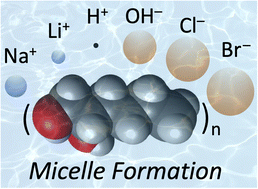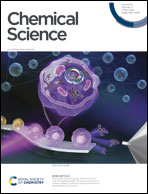Influence of H+, OH− and salts on hydrophobic self-assembly†
Abstract
In spite of the ubiquity of acid/base ions and salts in biological systems, their influence on hydrophobic self-assembly remains an open question. Here we use a combined experimental and theoretical strategy to quantify the influence of H+ and OH−, as well as salts containing Li+, Na+, Cl− and Br−, on the hydrophobic self-assembly of micelles composed of neutral oily 1,2-hexanediol surfactants. The distributions of aggregate sizes, both below and above the critical micelle concentration (CMC), are determined using Raman multivariate curve resolution (Raman-MCR) spectroscopy to quantify the multi-aggregation chemical potential surface (MCPS) that drives self-assembly. The results reveal that ions have little influence on the formation of hydrophobic contact dimers but can significantly drive high-order self assembly. Moreover, the hydration-shells of oily solutes are found to expel the above salt ions and OH−, but to attract H+, with wide-ranging implications.



 Please wait while we load your content...
Please wait while we load your content...